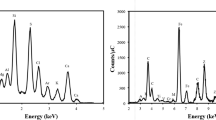Summary
The meteorological analysis of weather situations during which radioactive samples were collected, is described. It appears that precipitation washes out a significant part of the radioactive particles in the air. Successive samples from weather systems revealed that when precipitation was produced in the warm air mass only, the radioactivity concentration in the precipitation decreased with time and was independent of location. In order to explain this, a new weather system model is proposed, in which the main part of the precipitation is produced by uniform lifting of a warm air tongue.
Similar content being viewed by others
Reference
Martell E. A. &P. J. Drevinsky, 1960:Atmospheric Transport of Artificial Radioactivity. Science, vol. 132, 1523–1531.
Author information
Authors and Affiliations
Rights and permissions
About this article
Cite this article
Storebö, P.B. Application of nuclear-bomb debris as tracer for studies of weather systems. Geofisica Pura e Applicata 50, 222–228 (1961). https://doi.org/10.1007/BF02000648
Issue Date:
DOI: https://doi.org/10.1007/BF02000648




